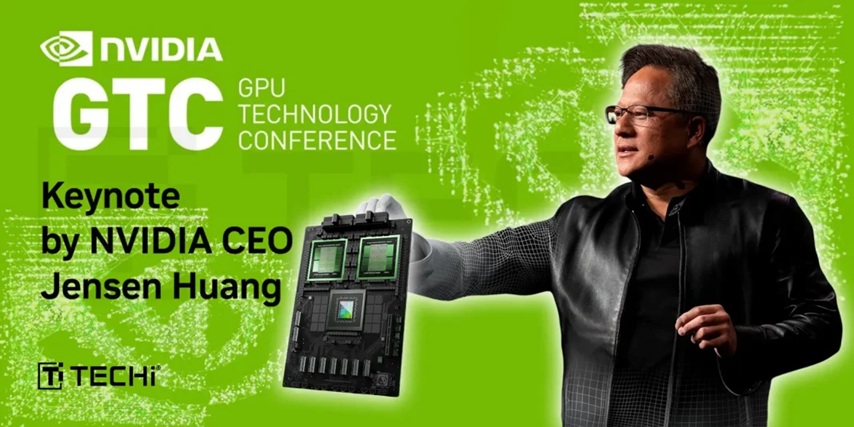
Introduction
NVIDIA’s GPU Technology Conference (GTC) 2025 is the company’s flagship annual event showcasing the latest advancements in AI, accelerated computing, graphics, and other GPU-powered technologies.
At this year’s GTC, CEO Jensen Huang unveiled the company’s latest AI chip technology. The event highlighted NVIDIA’s new Blackwell architecture and roadmap for future AI infrastructure development, demonstrating the company’s vision for accelerated computing across cloud, enterprise, and robotics applications.
At GTC 2025 — dubbed the “Super Bowl of AI” — Huang focused his keynote on the company’s AI advancements and industry predictions. He highlighted the surging demand for GPUs from the top four cloud service providers and projected NVIDIA’s data center infrastructure revenue to reach $1 trillion by 2028.
Huang’s highly anticipated announcement detailed NVIDIA’s next-generation graphics architectures: Blackwell Ultra and Vera Rubin — named for the famous astronomer. Blackwell Ultra is scheduled for the second half of 2025, while its successor, the Rubin AI chip, will launch in late 2026. Rubin Ultra will follow in 2027.
Video on GTC 2025:
Key Sections of the Video
CUDA Ecosystem and Accelerated Computing
Jensen Huang begins by discussing the importance of CUDA and its ecosystem of libraries that enable accelerated computing. He emphasizes that CUDA is not just a single piece of software but a comprehensive set of libraries integrated into various parts of the technology ecosystem. These libraries enable significant speedups across different domains, from scientific research to industry applications.
AI Infrastructure Evolution
A major focus of the presentation is the evolution of AI infrastructure from cloud-based solutions to more widespread enterprise adoption. Huang explains how AI started in cloud data centers due to their existing infrastructure but is now expanding everywhere, requiring new system configurations for different environments including enterprise IT, manufacturing, robotics, and self-driving cars.
Blackwell Architecture and AI Factory Concept
The most significant announcement is the Blackwell architecture, NVIDIA’s next-generation GPU designed specifically for AI workloads. Huang introduces the concept of “AI factories” – massive computing facilities optimized for token generation and inference tasks. He demonstrates how Blackwell delivers up to 25x performance improvement over the previous Hopper architecture within the same power envelope.
Future Roadmap and Silicon Photonics
Huang outlines NVIDIA’s roadmap for future architectures, including “Blackwell Ultra” and “Vera Rubin” platforms. He also introduces breakthrough technologies in silicon photonics that will enable scaling to millions of GPUs in future data centers, significantly reducing power consumption and increasing performance.
Robotics and Physical AI
The final section covers NVIDIA’s advancements in robotics, including the “Groot N1” generalist foundation model for humanoid robots and the new “Newton” physics engine developed in partnership with DeepMind and Disney Research. These technologies enable realistic simulation environments for training robots through AI.
Conclusion
Jensen Huang’s presentation showcases NVIDIA’s comprehensive strategy across multiple domains of AI computing. The company is positioning itself at the center of the AI revolution with solutions spanning from cloud infrastructure to enterprise computing and robotics.
5 Key Takeaways
- NVIDIA’s Blackwell architecture delivers 40x the performance of Hopper for AI inference workloads, representing a significant leap in AI processing capability.
- The company is introducing the concept of “AI factories” – optimized computing facilities that balance token generation speed with throughput for maximum efficiency.
- NVIDIA’s roadmap includes progressive scaling of their MVLink technology, with plans to reach 576 GPU connections in the Rubin Ultra architecture by 2027.
- Silicon photonics breakthroughs will enable massive scaling of GPU clusters while significantly reducing power consumption.
- NVIDIA is expanding beyond traditional computing into robotics with foundation models like Groot N1 and advanced physics simulation through the Newton engine.
References
- NVIDIA CUDA ecosystem and accelerated computing libraries
- Blackwell architecture and AI factory optimization metrics
- NVIDIA Dynamo operating system for AI workloads
- MVLink technology and scaling roadmap (Blackwell → Rubin → Rubin Ultra)
- Silicon photonics with micro-ring resonator technology
- Groot N1 foundation model for humanoid robots
- Newton physics engine for robotics simulation


